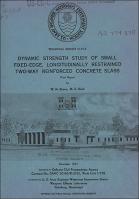Please use this identifier to cite or link to this item:
https://hdl.handle.net/11681/6751Full metadata record
| DC Field | Value | Language |
|---|---|---|
| dc.contributor | United States. Defense Civil Preparedness Agency | - |
| dc.contributor.author | Brown, Wayne M., 1942- | - |
| dc.contributor.author | Black, Michael S. | - |
| dc.date.accessioned | 2016-03-23T20:31:59Z | - |
| dc.date.available | 2016-03-23T20:31:59Z | - |
| dc.date.issued | 1973-12 | - |
| dc.identifier.uri | http://hdl.handle.net/11681/6751 | - |
| dc.description | Technical report | - |
| dc.description | Abstract: The study reported herein is one phase of an effort to develop criteria that will be helpful in evaluating or predicting the airblast load-carrying capacity of conventional floor slabs in existing Defense Civil Preparedness Agency approved shelters. The general objective of this study was to investigate the static and dynamic behavior of small, fixed-edge, longitudinally restrained, two-way reinforced concrete slabs. Twelve tests, four static and eight dynamic, were conducted on slabs with a clear span of 29 inches and a thickness of 0.89 inch. Two series of slabs (I and II) corresponding to two different percentages of steel reinforcement (0.78 and 1.17 percent) were used. The slabs were subjected to uniformly distributed static loads up to 36.5 psi using water pressure and to dynamic airblast overpressures ranging from 26.5 to 56.8 psi using explosives. Measurements of pressure, deflection, and reinforcement strains were made, and results are presented herein. The average ultimate collapse strengths of the slabs tested under static loading were 23.2 and 36.5 psi for the Series I and II slabs, respectively. The average values of ultimate flexural resistance were 14.1 and 18.2 psi for the Series I and II slabs, respectively. It was noted that the ultimate strength of the slabs was substantially increased by membrane action. Midspan deflections at the peak of tensile membrane action for the slabs tested statically averaged 4.40 inches for the Series I slabs and 4.10 inches for the Series II slab. The ultimate collapse strengths of the dynamically tested slabs averaged 28.7 and 45.5 psi for the Series I and II slabs, respectively. Midspan deflections at collapse of the slabs tested dynamically averaged 7.25 inches for the Series I slabs and 8.1 inches for the Series II slabs. A comparison of the ultimate collapse strengths of the slabs tested dynamically with those tested statically shows that increases in ultimate strength of 23.7 and 24.6 percent under dynamic loading were obtained for the Series I and II slabs, respectively. Slab strength was determined theoretically through the use of equations for predicting tensile membrane resistance and midspan deflection. After some modification of the equations used, good predictions of tensile membrane resistance of the static slabs were realized. These equations were also used in predicting the peak pressures sustained by the dynamic slabs. Using the equations to predict dynamic slab strength was less successful than using the equations to predict static slab strength. | - |
| dc.publisher | Weapons Effects Laboratory (U.S.) | - |
| dc.publisher | Engineer Research and Development Center (U.S.) | - |
| dc.relation | http://acwc.sdp.sirsi.net/client/en_US/search/asset/1047892 | - |
| dc.relation.ispartofseries | Technical report (U.S. Army Engineer Waterways Experiment Station) ; N-73-8. | - |
| dc.rights | Approved for public release; distribution is unlimited. | - |
| dc.source | This Digital Resource was created from scans of the Print Resource. | - |
| dc.subject | Dynamic loads | - |
| dc.subject | Reinforced concrete | - |
| dc.subject | Slabs | - |
| dc.subject | Static loads | - |
| dc.title | Dynamic strength study of small, fixed-edge, longitudinally restrained two-way reinforced concrete slabs | - |
| dc.type | Report | en_US |
| Appears in Collections: | Technical Report | |
Files in This Item:
| File | Description | Size | Format | |
|---|---|---|---|---|
| TR-N-73-8.pdf | 6.62 MB | Adobe PDF |  View/Open |